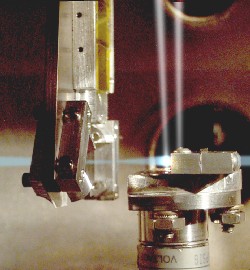Plasma Puts the Squeeze on Positrons

A group of researchers has focused an energetic bunch of positrons (antielectrons) using a plasma cloud. The plasma canceled repulsive fields in the bunch, which caused it to compress to roughly half its original volume. These results, presented in the 10 December print issue of PRL, prove that plasma lenses can work at high energies–opening the possibility of using them in the next generation of linear colliders.
To probe the electroweak force, future experiments will collide beams of high-energy electrons with those of positrons. To insure that the fast moving electrons and positrons don’t fly past one another, designers need to make the beam pulses as dense as possible. The density of each pulse is determined by two opposing forces: The mutual repulsion between the particles causes the cloud to drift apart, and a magnetic field induced by the collective motion of the particle “bunch” causes it to squeeze more tightly together. Researchers believed that if they neutralize the repulsive force, the beam could pinch itself to a higher density.
For over a decade, beam scientists have hoped to eliminate the repulsion by passing the pulses through small clouds of ionized gas (plasma) just before the electron-positron collision. A plasma’s charges always try to arrange themselves in a way that cancels electric fields, so researchers thought it could eliminate the repellent forces of the beams. In effect, the plasma would act as an optical lens–squeezing the particles tightly together.
Researchers have already used plasma lenses to compress electrons at low energies, but they had doubts about whether they could use the lenses on positrons, or whether they would be effective enough at the high energies of future particle accelerators. To find out, Clive Field of the Stanford Linear Accelerator Center (SLAC) in California and his colleagues fired a stream of 28.5 GeV positrons into a jet of laser-ionized gas. What emerged from the plasma, says Field, was a positron group with twice its original density.
“I think it was an excellent experiment,” says James Rosenzweig of the University of California in Los Angeles (UCLA). Rosenzweig believes that these initial results will encourage others to probe more complex beam-plasma interactions.
–Geoff Brumfiel


